Sri Lanka out of intensive care, but still in the trauma ward
Author: Editorial Board, ANU
If you think your New Year hangover was bad, spare a thought for Sri Lanka. In 2022 what was once a dynamic economy on its way to high middle-income status became a cautionary tale of how rotten politics, and the bad policy it produces, can trump otherwise promising economic prospects.
![]()
As Dushni Weerakoon writes in this week’s lead article, a continuation of our Year in Review series on the major developments of the year across the region, Sri Lanka has set out on a hard road to recovery in a political environment not conducive to the structural reforms the country needs to achieve its potential.
In the short term, ‘Sri Lanka is banking on an IMF bailout to facilitate access to bilateral and multilateral financial support to get the economy back on track.’ Progress is being made in securing a deal, with the IMF agreeing access to US$2.9 billion under its Extended Fund Facility and the World Bank confirming Sri Lanka has ‘reverse graduated’ to be eligible for concessional finance under the International Development Association. But with Sri Lanka having an unwieldy mix of private and official creditors, the IMF program will require financing assurances and a good faith effort from creditors to restore debt sustainability before Sri Lanka is able to get the support it seeks.
Further bad news, Weerakoon says, is that ‘the standard IMF policy prescription that demands stringent financial discipline means that adjustment costs will be front-loaded, preventing the government from spending its way out of recession. Accordingly, taxes are being hiked and expenditures are being cut’ to get the Fund’s money in the door.
From the IMF’s perspective, this is a feature of the Extended Fund Facility, rather than a bug. The IMF program is intended to help Sri Lanka restore macroeconomic stability and implement necessary reforms, including anti-corruption reforms, to address medium-term balance of payments challenges — rather than subsidising the government’s day-to-day expenses. ‘Even if everything goes according to plan, it will be another two or three years before the Sri Lankan public feels any real improvement in economic conditions.’
That timeframe could be of great importance. As Weerakoon notes, ‘[w]ith all the uncertainties, next year will be crucial for Sri Lanka as it gears up for the all-important presidential elections in 2024.’ Until then President Ranil Wickremasinghe — an ally of the ousted Rajapaksa brothers who was installed by parliament after they fled the country in July 2022 — will navigate both the international debt restructuring negotiations and the domestic policies they entail without any electoral mandate.
For this reason, as Weerakoon says, ‘[a]n economic crisis can sometimes be the catalyst of a major economic overhaul, but in the absence of political stability the downside risks are significant. Governments have far fewer resources in hand to compensate those who are bound to lose out from reforms.’
The Sri Lanka situation occurs against the backdrop of the need for new modes of global debt governance as the international landscape of sovereign creditors becomes more diverse, with China, the Gulf states and India, and private and state-owned creditors based in these countries, all claiming larger roles as development financiers abroad.
As the role of non-traditional creditors grows, governance frameworks for global debt need to change. Recent controversies over the role that Chinese lenders have played in the debt crises afflicting Tonga and Tanzania haven’t substantiated the ‘debt trap’ narrative — nor has China’s role in Sri Lanka’s current problems. Rather, they’ve obscured a more mundane but equally concerning reality: that Chinese lenders got out over their skis in extending loans abroad, driven by a complex mixture of domestic commercial and bureaucratic interests. It’s in everybody’s interest, including China’s, that its overseas lending practices are guided by more clearly-articulated policy principles and are executed with more transparency that has been the case so far.
The impulse to make the developing-world’s debt problem the object of geopolitical rivalry shouldn’t distract from a more worthwhile goal: to fold China, as well as the other emerging non-traditional leaders into fit-for-the times coordination — and, if necessary, adapting those frameworks to the reality that business as usual is increasingly an anachronism. As the World Bank’s chief economist warned in a recent interview, ‘we are applying a restructuring model that was devised for another time’, when Western governments or multilateral lenders were dominant. The Paris Club creditors’ coordination group no longer reflects the creditor mix in emerging economies.
Change is in the interests of all the stakeholders in this mix. The need for multilateral economic coordination through bodies like the G20 couldn’t be clearer. The beleaguered G20 Common Framework for Debt Treatments beyond the DSSI has had only one country achieve debt restructuring in two years. One significant improvement could be expanding eligibility to middle-income countries: until its December ‘reverse graduation’ under the World Bank, Sri Lanka was ineligible — as alluded to in the 2022 Bali G20 Leaders Declaration which noted that members were ‘concerned about the deteriorating debt situation in some vulnerable middle-income countries’.
Sri Lanka will likely face economic pressures for much of the decade ahead, but it would do well to take inspiration from the experience of the region in moving past the Asian Financial Crisis. Indonesia was forced to ‘reverse graduate’ in 1999 in order to access concessional finance but proceeded to graduate again in 2008 and is now a powerhouse economy in the region, whose sustained run of sound macroeconomic management can in no small part be put down to the memories of the traumas of the crisis and its aftermath.
If there’s a silver lining to the hard years ahead for Sri Lanka, it is to be found in the hope that its elites will never allow a repeat of the abysmal policymaking that its people are now paying for with their economic livelihoods.
The EAF Editorial Board is located in the Crawford School of Public Policy, College of Asia and the Pacific, The Australian National University.
Sri Lanka's anti-government protests have gone silent - for now
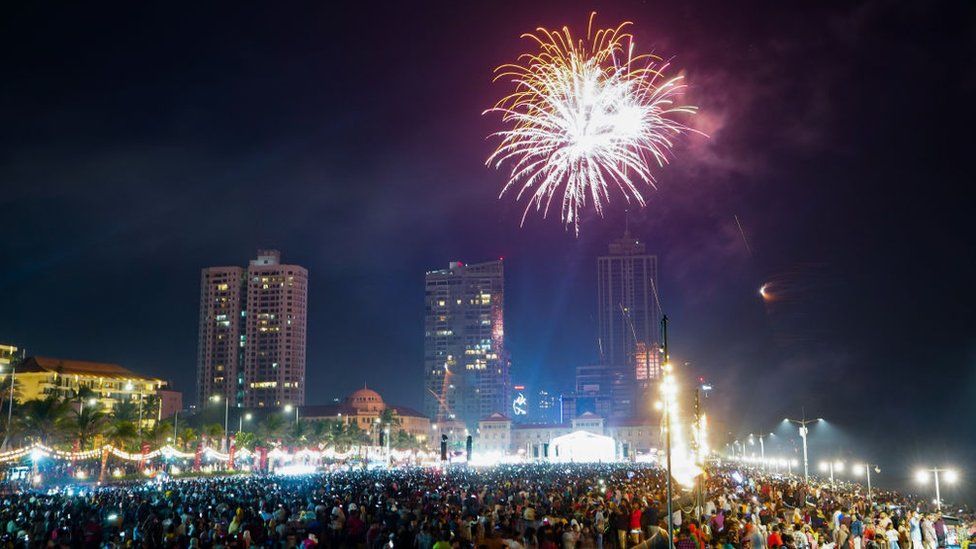 GETTY IMAGES
GETTY IMAGESLong gone are the throngs of protesters who occupied an area around the president's office for months during Sri Lanka's worst economic crisis since independence.
Instead a slew of carollers sang to the public from across the heavily-guarded fences of the Presidential Secretariat. Next to the building rose an 80 ft (24m) Christmas tree, the signature piece in a landscape dotted with décor, food stalls and musical shows. And as fireworks ushered in the new year, a massive crowd flocked to the oceanfront promenade known as Galle Face Green.
It was all part of a festive zone planned by the government as a year-end tourist attraction in the central business district of Colombo, Sri Lanka's capital.
But for many locals, who used the site as their "ground zero" for Occupy-style protests from April to August and demanded their leaders resign, there is little to celebrate.
"It's disgusting," says Swasthika Arulingam. "It's an indecent display of wealth that this country does not have, and of resources this country is denying to the weakest sectors of our population."
The carnival lighting is particularly galling, she adds, given that the state-run electricity board has incurred a loss of 150bn Sri Lankan rupees (£344m) this year.
The prospect of extended daily blackouts looms again. Food staples, transport fees and children's school supplies are increasingly unaffordable. And the new year brings with it steep tax hikes that will only compound the misery.
There is "a kind of pseudo-stability" right now, Ms Arulingam says, but residents are under tremendous stress as it grows harder to make a living.
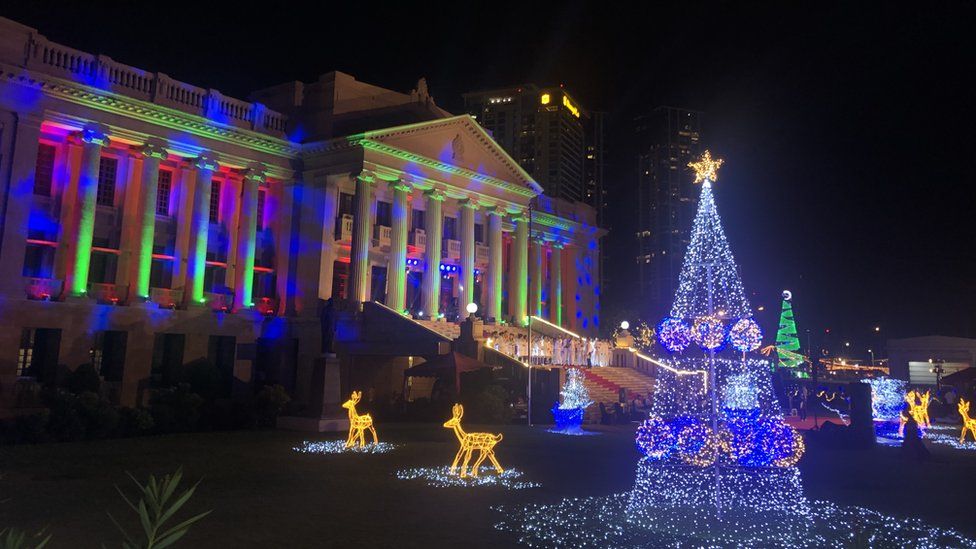 SAM CABRAL
SAM CABRALThrough much of last year, Sri Lankans faced acute shortages of food, fuel and other basic supplies after a slew of government policies followed by the pandemic had depleted foreign reserves and left the country teetering on the edge of bankruptcy. Lengthy fuel queues and power outages sparked months of mass unrest, culminating in the storming and occupation of then-President Gotabaya Rajapaksa's official workplace and residence in July, forcing him to flee the country.
Six months on, with more pain on the horizon, there have been calls for early elections. Mr Rajapaksa's parliament-appointed replacement, Ranil Wickremesinghe, has largely demurred, but local government elections are expected to take place next month after a one-year delay.
Mr Wickremesinghe has also cracked down on the anti-government protest movement and its leaders, after vowing that he will not allow "fascists" to "tear up our constitution".
"Any form of protest is controlled in Sri Lanka right now," says Shreen Saroor, a local human rights campaigner. "He has kept his powers well intact to do what he needs to do and in case he needs to call on the military to control the country."
Ms Saroor points to how Mr Wickremesing has retained the powers of executive presidency - he can deploy security forces, and issue detention orders under what is known as the Prevention of Terrorism Act (PTA).
Critics say the system, which heavily centralises power in the hands of the president, was bolstered by the Rajapaksas during their two decades in power, and lacks the appropriate checks and balances. Calls for abolishing it and reforming the constitution were a key demand in last year's protests.
Father Jeewantha Peiris, a Catholic clergyman, is among the protest leaders who have been charged with various criminal offences, including assault and unlawful assembly, under PTA. He is fighting back in court against what he calls "baseless accusations".
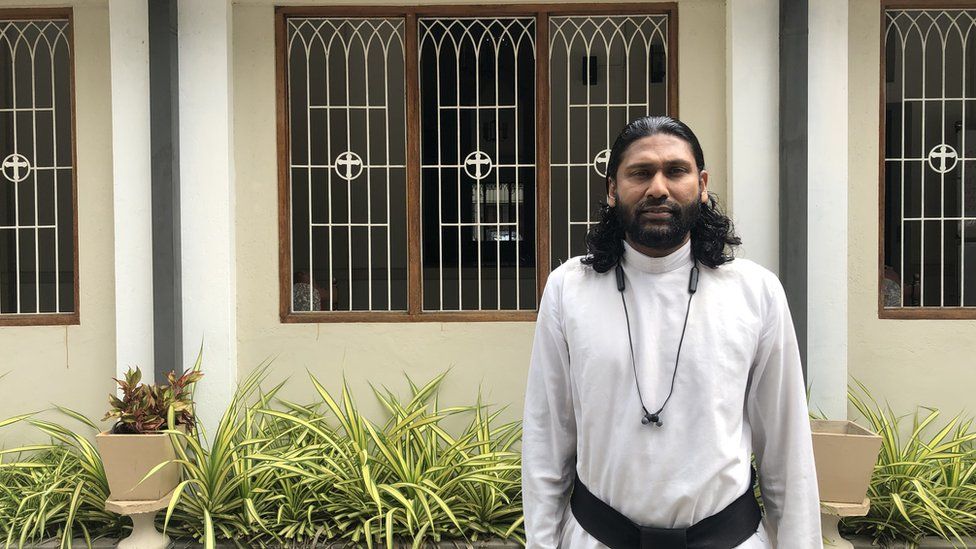 SAM CABRAL
SAM CABRALParliament "totally betrayed" the people when they voted in Mr Wickremesinghe as president, he says, referring to the former six-time prime minister as "another culprit who had been engaged with the corrupt system".
"Apparently the crisis is now solved but, underneath, its real causes have not been treated," he says. "Corruption is still taking place. Real issues like malnutrition and medicine shortages exist. Downtrodden people cannot face this inflation."
The state is intimidating citizens like him, he alleged, but "unless they bring to account those who have committed economic injustices and violated human rights, this crisis will not be solved".
Father Peiris is the parish priest to mostly Tamil-minority rubber estate workers in the village of Doloswala in the south-central Ratnapura district. He says successive governments have neglected Sri Lanka's poorest and most vulnerable.
When the pandemic arrived, he claims, villagers fell ill in droves with no ability to socially distance inside their homes and no access to vaccines - and with schools shut, their children suffered with no prospect of remote learning.
"Mothers would come to my cottage and cry for their starving children," he says. "As a priest working among them, I could not wait around and watch them in their daily misery."
With his black locks and pristine white cassock, the parishioner was at the Galle Face Green protests every day. His message: the country needs a national movement for structural change.
He describes it as the first time Sri Lankans united, in a struggle for the greater good, irrespective of race, religion or ideology: "We had no divisions among us and we all felt we were victims."
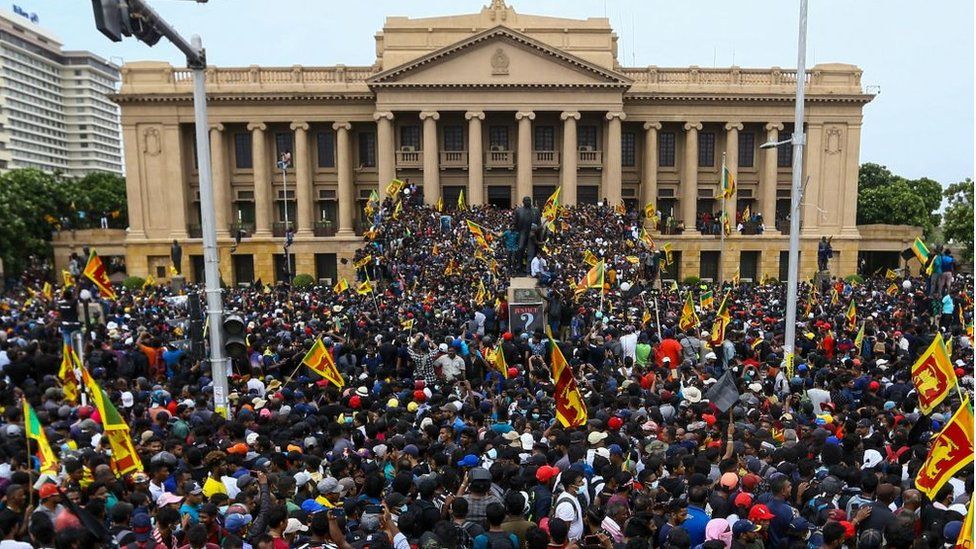 GETTY IMAGES
GETTY IMAGESBeginning on 9 April, daily demonstrations quickly grew into "GotaGoGama" - a word that combines the Sinhalese word for "village" with protesters' demand for Mr Rajapaksa to step down as president.
Camped opposite the Presidential Secretariat, the little community spawned rallies, candlelight vigils, stage dramas and a huge library of donated books, all focused on broadening political literacy.
It commemorated atrocities from Sri Lanka's past, held open forums about minority divisions and, when government-aligned thugs brutally laid siege to the site, grew even stronger.
But by July, as protesters grew increasingly restive over Mr Rajapaksa's refusal to leave office, the crowds had grown larger and more uncontrollable.
In the days after the president's home and office were stormed, as Mr Rajapaksa fled to the Maldives and finally resigned, security forces under the orders of his successor reclaimed the two buildings and raided the GotaGoGama protest camp, arresting demonstrators and dismantling their tents.
With many of its key figures now behind bars, facing legal action or under regular surveillance, the so-called "aragalaya" - or people's struggle in Sinhala - has largely gone silent.
"It was a national movement, a vision of what Sri Lanka could be," says Dr Paikiasothy Saravanamuttu, founder of the Centre for Policy Alternatives, but "the middle class has deserted it, the ordinary community groups have all deserted it".
"[Mr Wickremesinghe] successfully changed the narrative to show there's a good aragalaya and a bad aragalaya, and what we're now lumped with is the bad aragalaya," he says.
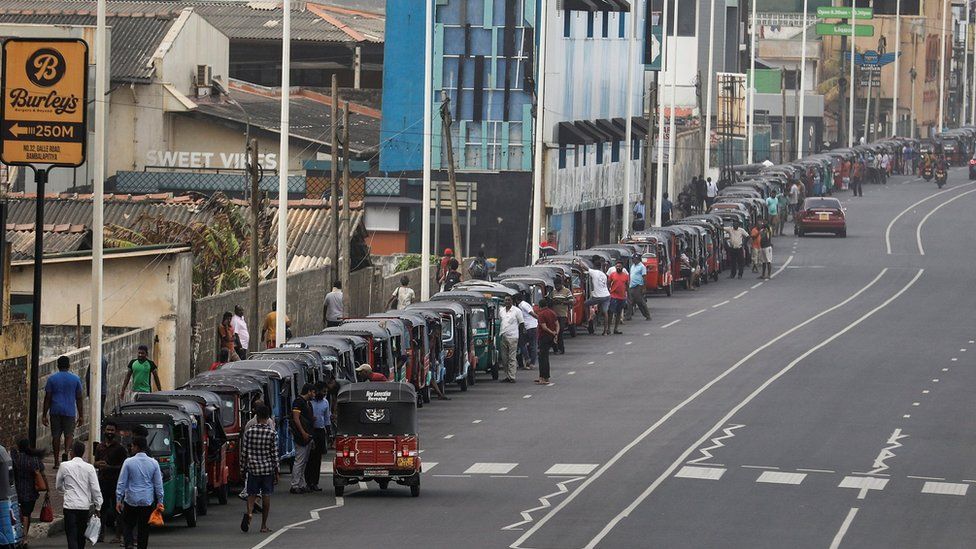 REUTERS
REUTERSDr Saravanamuttu argues that sections of the population, particularly older Sri Lankans, view Mr Wickremesinghe as the best possible option to salvage the cash-strapped economy, but he must adhere to a reasonable timetable for elections at the local and presidential level.
"The sooner we have some legitimacy, the better," he adds. "But from Ranil's point of view, he wants to be elected president of this country, so he's not going to do anything that will register a huge rebuke against any government that he is heading."
As Sri Lanka waits on a US$2.9bn (£2.4bn) IMF bailout and financing assurances from China and other bilateral creditors, its people will struggle for a while longer. Dr Saravanamuttu warns a fresh outbreak of mass protests is on the cards in the near future, particularly in areas outside of Colombo where people are poorer and will be hit harder by rising food costs and fuel shortages.
"People will come out, not because they want constitutional reform or they want impunity checked, but because they can't survive," he says. "And that might be more dangerous, because it will be spontaneous and it will have a them-versus-us dimension."
For Buwanaka Perera, a 27-year old social media activist who helped organise the GotaGoGama protests, whatever comes next, the protest movement of 2022 has left a permanent mark.
"People stood up against monsters and gave them the finger," he says.
"We managed to send Gotabaya home. If people could send him fleeing, and hiding in [army] camps and on islands, there's no stepping back from that."

